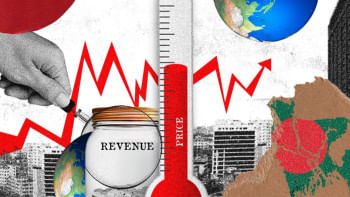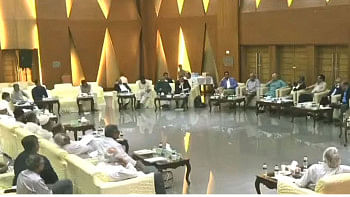Economy grew 4.86% in Jan-Mar

Bangladesh's economy grew by 4.86 percent in the January-March period of the fiscal year 2024-25, the quickest pace in nearly two years, driven by a recovery in both industry and services, according to provisional figures released by the Bangladesh Bureau of Statistics yesterday.
The year-on-year growth in gross domestic product (GDP) was slightly higher than the 4.62 percent recorded in the same quarter a year earlier.
Growth in the first two quarters of the just-concluded fiscal year stood at 1.96 percent and 4.48 percent, respectively. In comparison, GDP rose by 5.87 percent and 4.47 percent during the corresponding quarters of FY 2023-24.
In the January-March period of FY25, industrial output picked up by 6.91 percent, up from 4.55 percent a year ago.
The services sector, which accounts for more than half of the economy, posted growth of 5.88 percent, compared to 4.31 percent in the same period last year.
Agriculture, however, saw a slowdown. Growth in the farming sector stood at 2.42 percent, down from the figure recorded a year earlier.
The statistics bureau projected that overall GDP growth for the full 2024-25 fiscal year will be 3.97 percent, the weakest rate since the pandemic.
The provisional estimate was published on May 27.
This figure closely matches forecasts by international lenders. The International Monetary Fund (IMF) has estimated growth at 3.8 percent, while the Asian Development Bank expects a 3.9 percent expansion in FY25.
The latest January-March GDP estimate by the statistical agency surprised economists.
Fahmida Khatun, executive director of the local think tank Centre for Policy Dialogue (CPD), said the source of this sudden uptick remains unclear. "It is not evident where the growth has come from," she said.
"During this period, inflation was high and economic activity was slow, so the calculation does not add up."
She said the data did not reflect the economic reality on the ground and expressed doubt over the accuracy of the figure.
Selim Raihan, executive director of the South Asian Network on Economic Modeling (Sanem), also said he was puzzled by the estimate, especially given the lack of major economic changes and much weaker growth in the other quarters.
Raihan questioned the claim of easing inflation, arguing that market conditions did not support it.
He also pointed to low private sector credit growth, weak investor sentiment and sluggish business activity.
Taken together, the economist said, these factors made such strong quarterly growth appear unlikely and potentially at odds with the broader state of the economy.

 For all latest news, follow The Daily Star's Google News channel.
For all latest news, follow The Daily Star's Google News channel. 





Comments